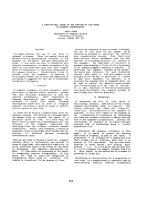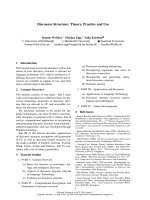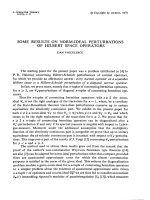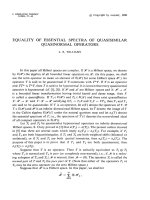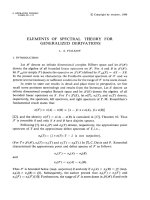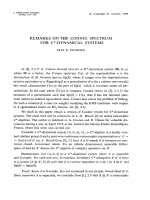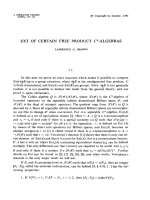Báo cáo toán học: ": ALGEBRAIC MATCHING THEORY" pot
Bạn đang xem bản rút gọn của tài liệu. Xem và tải ngay bản đầy đủ của tài liệu tại đây (220.07 KB, 14 trang )
ALGEBRAIC MATCHING THEORY
C. D. Godsil
1
Department of Combinatorics and Optimization
University of Waterloo
Waterloo, Ontario
Canada N2L 3G1
Submitted: July 6, 1994; Accepted: April 11, 1995.
Abstract: The number of vertices missed by a maximum matching in a graph
G is the multiplicity of zero as a root of the matchings polynomial µ(G, x)of
G, and hence many results in matching theory can be expressed in terms of
this multiplicity. Thus, if mult(θ,G) denotes the multiplicity of θ as a zero of
µ(G, x), then Gallai’s lemma is equivalent to the assertion that if mult(θ, G\u) <
mult(θ, G) for each vertex u of G, then mult(θ, G)=1.
This paper extends a number of results in matching theory to results con-
cerning mult(θ,G), where θ is not necessarily zero. If P is a path in G then
G \ P denotes the graph got by deleting the vertices of P from G.Weprove
that mult(θ, G \P ) ≥ mult(θ, G) − 1, and we say P is θ-essential when equality
holds. We show that if, all paths in G are θ-essential, then mult(θ,G)=1. We
define G to be θ-critical if all vertices in G are θ-essential and mult(θ, G)=1.We
prove that if mult(θ, G)=k then there is an induced subgraph H with exactly k
θ-critical components, and the vertices in G \ H are covered by k disjoint paths.
AMS Classification Numbers: 05C70, 05E99
1
Support from grant OGP0009439 of the National Sciences and Engineering Council
of Canada is gratefully acknowledged.
1. Introduction
A k-matching in a graph G is a matching with exactly k edges and the number of k-
matchings in G is denoted by by p(G, k). If n = |V (G)| we define the matchings polynomial
µ(G, x)by
µ(G, x):=
k≥0
(−1)
k
p(G, k)x
n−2k
.
(Here p(G, 0) = 1.) By way of example, the matchings polynomial of the path on four
vertices is x
4
−3x
2
+1. The matchings polynomial is related to the characteristic polynomial
φ(G, x)ofG, which is defined to be the characteristic polynomial of the adjacency matrix
of G. In particular φ(G, x)=µ(G, x)ifandonlyifG is a forest [4: Corollary 4.2]. Also the
matchings polynomial of any connected graph is a factor of the characteristic polynomial
of some tree. (For this, see Theorem 2.2 below.)
Let mult(θ, G) denote the multiplicity of θ as a zero of µ(G, x). If θ =0thenmult(θ, G)
is the number of vertices in G missed by a maximum matching. Consequently many
classical results in the theory of matchings provide information related to mult(0,G). We
refer in particular to Gallai’s lemma and the Edmonds-Gallai structure theorem, which we
now discuss briefly.
Avertexu of G is θ-essential if mult(θ, G\u) < mult(θ, G). So a vertex is 0-essential if
and only if it is missed by some maximum matching of G. Gallai’s lemma is the assertion
that if G is connected, θ = 0 and every vertex is θ-essential then mult(θ, G)=1. (Amore
traditional expression of this result is given in [8: §3.1].) A vertex is θ-special if it is not
θ-essential but has a neighbour which is θ-essential. The Edmonds-Gallai structure in large
part reduces to the assertion that if θ = 0 and v is a θ-special vertex in G then a vertex u
is θ-essential in G and if and only if it is θ-essential in G\ v. (For more information, see
[8: §3.2].) One aim of the present paper is to investigate the extent to which these results
are true when θ =0.
Thereisasecondsourceofmotivationforourwork.HeilmanandLiebprovedthatif
G has a Hamilton path then all zeros of µ(G, x) are simple. (This is an easy consequence
of Corollary 2.5 below.) Since all known vertex-transitive graphs have Hamilton paths
we are lead to ask whether there is a vertex-transitive graph G such that µ(G, x) has a
multiple zero. As we will see, it is easy to show that if θ is a zero of µ(G, x)andG is
vertex-transitive then every vertex of G is θ-essential. Hence, if we could prove Gallai’s
lemma for general zeros of the matchings polynomial, we would have a negative answer to
this question.
2. Identities
The first result provides the basic properties of the matchings polynomial µ(G, x). We
write u ∼ v to denote that the vertex u is adjacent to the vertex v. For the details see, for
example, [6: Theorem 1.1].
2.1 Theorem. The matchings polynomial satisfies the following identities:
(a) µ(G ∪ H,x)=µ(G, x) µ(H, x),
(b) µ(G, x)=µ(G \ e, x) − µ(G \ uv, x) if e = {u, v} is an edge of G,
(c) µ(G, x)=xµ(G \ u, x) −
i∼u
µ(G\ ui, x),if u ∈ V (G),
(d)
d
dx
µ(G, x)=
i∈V (G)
µ(G \ i, x).
Let G beagraphwithavertexu.ByP(u)wedenotethesetofpathsinG which
start at u.Thepath tree T (G, u)ofG relative to u has P(u) as its vertex set, and two
paths are adjacent if one is a maximal proper subpath of the other. Note that each path in
P(u) determines a path starting with u in T (G, u) and with same length. We will usually
denote them by the same symbol. The following result is taken from [6: Theorem 6.1.1].
2.2 Theorem. Let u be a vertex in the graph G and let T = T (G, u) be the path tree of
G with respect to u.Then
µ(G\ u, x)
µ(G, x)
=
µ(T \ u, x)
µ(T,x)
and, if G is connected, then µ(G, x) divides µ(T,x).
Because the matchings polynomial of a tree is equal to the characteristic polynomial
of its adjacency matrix, its zeros are real; consequently Theorem 2.2 implies that the zeros
of the matchings polynomial of G are real, and also that they are interlaced by the zeros
of µ(G \ u, x), for any vertex u. (By interlace, we mean that, between any two zeros of
µ(G, x), there is a zero of µ(G \ u, x). This implies in particular that the multiplicity of a
zero θ in µ(G, x)andµ(G\u, x)candifferbyatmostone.) Foramoreextensivediscussion
of these matters, see [6: §6.1].
We will need a strengthening of the first claim in Theorem 2.2.
2.3 Corollary. Let u be a vertex in the graph G and let T = T (G, u) be the path tree
of G with respect to u.IfP ∈P(u) then
µ(G\ P, x)
µ(G, x)
=
µ(T \ P, x)
µ(T,x)
.
Proof. We proceed by induction on the number of vertices in P.IfP has only one vertex,
we appeal to the theorem. Suppose then that P has at least two vertices in it, and that v
is the end vertex of P other than u.LetQ be the path P \v and let H denote G\Q.Then
µ(G \ P, x)
µ(G, x)
=
µ(G \ P, x)
µ(G \ Q, x)
µ(G\ Q, x)
µ(G, x)
=
µ(T(H, v) \ v, x)
µ(T (H, v),x)
µ(T \Q, x)
µ(T,x)
,
where the second equality follows by induction. Now T (H, v) is one component of T (G, u)\
Q, and if we delete the vertex v from this component from T (G, u) \ Q, the graph that
results is T (G, u) \ P . Consequently
µ(T (H, v) \ v, x)
µ(T(H, v),x)
=
µ(T \P,x)
µ(T \Q, x)
.
The results follows immediately from this.
Let P(u, v) denote the set of paths in G which start at u and finish at v. The following
result will be one of our main tools. It is a special case of [7: Theorem 6.3].
2.4 Lemma (Heilmann and Lieb). Let u and v be vertices in the graph G.Then
µ(G\ u, x) µ(G \ v,x) − µ(G, x) µ(G\ uv, x)=
P ∈P (u,v)
µ(G\ P, x)
2
.
This lemma has a number of important consequences. In [5: Section 4] it is used to
show that mult(θ, G) is a lower bound on the number of paths needed to cover the vertices
of G, and that the number of distinct zeros of µ(G, x) is an upper bound on the length of
a longest path. For our immediate purposes, the following will be the most useful.
2.5 Corollary. If P is a path in the graph G then µ(G \ P,x)/µ(G, x) has only simple
poles. In other words, for any zero θ of µ(G, x) we have
mult(θ, G\ P) ≥ mult(θ, G) − 1.
Proof. Suppose k =mult(θ, G). Then, by interlacing, mult(θ, G\u) ≥ k −1 for any vertex
u of G and mult(θ, G\ uv) ≥ k − 2. Hence the multiplicity of θ as a zero of
µ(G\ u, x) µ(G \ v,x) − µ(G, x) µ(G\ uv, x)
is at least 2k − 2. It follows from Lemma 2.4 that mult(θ, G\ P ) ≥ k − 1 for any path P
in P(u, v).
3. Essential Vertices and Paths
Let θ be a zero of µ(G, x). A path P of G is θ-essential if mult(θ, G\P ) < mult(θ, G). (We
will often be concerned with the case where P is a single vertex.) A vertex is θ-special if it is
not θ-essential and is adjacent to an θ-essential vertex. A graph is θ-primitive if and only if
every vertex is θ-essential and it is θ-critical if it is θ-primitive and mult(θ, G) = 1. (When
θ is determined by the context we will often drop the prefix ‘θ-’ from these expressions.)
If θ =0thenaθ-critical graph is the same thing as a factor-critical graph.
The next result implies that a vertex-transitive graph is θ-primitive for any zero θ of
its matchings polynomial.
3.1 Lemma. Any graph has at least one essential vertex.
Proof. Let θ be a zero of µ(G, x) with multiplicity k.Thenθ has multiplicity k − 1asa
zero of µ
(G, x). Since
µ
(G, x)=
u∈V (G)
µ(G \ u, x)
we see that if mult(θ, G \ u) ≥ k for all vertices u of G then θ must have multiplicity at
least k as a zero of µ
(G, x).
3.2 Lemma. If θ =0then any θ-essential vertex u has a neighbour v such that the path
uv is essential.
Proof. Assume θ =0andletu be a θ-essential vertex. Since
µ(G, x)=xµ(G\ u, x) −
i∼u
µ(G\ ui, x)
we see that if mult(θ, G \ ui) ≥ mult(θ, G) for all neighbours i of u then mult(θ, G \ u) ≥
mult(θ, G).
Note that the vertex v is not essential in G \ u. However it follows from the next
lemma that the vertex v in the above lemma must be essential in G; accordingly if θ =0
then any essential vertex must have an essential neighbour.
3.3 Lemma. If v is not an essential vertex of G then no path with v as an end-vertex
is essential.
Proof. Assume k =mult(θ,G). If v is not essential then mult(θ, G\v) ≥ k and so, for any
vertex u not equal to v, the multiplicity of θ as a zero of
µ(G\ u, x) µ(G \ v,x) − µ(G, x) µ(G\ uv, x)
is at least 2k−1. By Lemma 2.4 we deduce that it is at least 2k and that mult(θ,G\P ) ≥ k
for all paths P in P(v).
We now need some more notation. Suppose that G is a graph and θ is a zero of µ(G, x)
with positive multiplicity k.Avertexu of G is θ-positive if mult(θ, G \ u)=k + 1 and
θ-neutral if mult(θ, G\u)=k. (The ‘negative’ vertices will still be referred to as essential.)
Note that, by interlacing, mult(θ, G\u)cannotbegreaterthank +1.
3.4 Lemma. Let G be a graph and u avertexinG which is not essential. Then u is
positive in G if and only if some neighbour of it is essential in G \ u.
Proof. From Theorem 2.1(c) we have
µ(G, x)=xµ(G\ u, x) −
i∼u
µ(G\ ui, x). (3.1)
If mult(θ,G\u)=k +1and mult(θ, G\ui) ≥ k + 1 for all neighbours i of u then it follows
that mult(θ, G) ≥ k + 1 and u is not positive.
On the other hand, suppose u is not essential in G and v is a neighbour of u which is
essential in G \ u. From the previous lemma we see that the path uv is not essential and
thus mult(θ, G\uv) ≥ mult(θ, G). As v is essential in G\u it follows that mult(θ, G\u) >
mult(θ, G).
We say that S is an extremal subtree of the tree T if S is a component of T \ v for
some vertex v of G.
3.5 Lemma. Let S be an extremal subtree of T that is inclusion-minimal subject to the
condition that mult(θ, S) =0,andletv be the vertex of T such that S is a component of
T \ v.Thenv is θ-positive in T .
Proof. Let u be the vertex of S adjacent to v and let e be the edge {u, v}.ThenT \ e has
exactly two components, one of which is S. Denote the other by R.
By hypothesis mult(θ, S
) = 0 for any component S
of S\u, therefore mult(θ, S\u)=0
by Theorem 2.1(a) and so u is essential in S.SinceS is a component of T \ v it follows
that u is essential in T \ v. If we can show that v is not essential then v must be positive
in T , by the previous lemma.
Suppose mult(θ,T)=m. By interlacing mult(θ, T \ u) ≥ m − 1 and, as
mult(θ, T \ u)=mult(θ, R)+mult(θ, S \ u)=mult(θ, R),
we find that mult(θ, R) ≥ m − 1. By parts (a) and (b) of Theorem 2.1 we have
µ(T,x)=µ(R, x) µ(S, x) − µ(R \ v, x) µ(S \ u, x)
and so, since the multiplicity of θ asazeroofµ(R, x) µ(S, x)isatleastm,wededucethat
the multiplicity of θ as a zero of µ(R\v, x) µ(S\u, x)isatleastm. Since mult(θ, S\u)=0,
it follows that mult(θ, R\ v) ≥ m. On the other hand
mult(θ, T \ v)=mult(θ, R \ v)+mult(θ, S)=mult(θ, R\ v)+1,
therefore mult(θ, T \ v) ≥ m + 1 and v is positive in T .
3.6 Corollary (Neumaier). Let T be a tree and let θ be a zero of µ(T,x). The following
assertions are equivalent:
(a) mult(θ, S)=0for all extremal subtrees of T ,
(b) T is θ-critical,
(c) T is θ-primitive.
Proof. Since T \v is a disjoint union of extremal subtrees for any vertex v in T ,weseethat
if (a) holds then mult(θ, T \ v) = 0 for any vertex v.HenceT is θ-critical and therefore it
is also θ-primitive. If T is θ-primitive then no vertex in T is θ-positive, whence Lemma 3.5
implies that (a) holds.
Corollary 3.6 combines Theorem 3.1 and Corollary 3.3 from [9]. Note that the equiv-
alence of (b) and (c) when θ = 0 is Gallai’s lemma for trees.
3.7 Lemma. Let G be a connected graph. If u ∈ V (G) and all paths in G starting at u
are essential then G is critical.
Proof. If all paths in P(u) are essential then Lemma 3.3 implies that all vertices in G are
essential. Hence G is primitive, and it only remains for us to show that mult(θ,G)=1.
Let T = T (G, u) be the path tree of G relative to u. From Theorem 2.2 we see that
a path P from P(u)isessentialinG if and only if it is essential in T .Soourhypothesis
implies that all paths in T which start at u are essential, whence Lemma 3.3 yields that
all vertices in T are essential. Hence T is θ-primitive and therefore, by Corollary 3.6, θ is
a simple zero of µ(T,x). Using Theorem 2.2 again we deduce that mult(θ, G)=1.
3.8 Lemma. If u and v are essential vertices in G and v is not essential in G \ u then
there is a θ-essential path in P(u, v).
Proof. Assume mult(θ, G)=k. Our hypotheses imply that mult(θ, G\ uv) ≥ k − 1. If no
path in P(u, v) is essential then, by Lemma 2.4, the multiplicity of θ as a zero of
µ(G\ u, x) µ(G \ v,x) − µ(G, x) µ(G\ uv, x)
is at least 2k.Sinceθ has multiplicity 2k − 1 as a zero of µ(G, x) µ(G \ uv, x)itmustalso
have multiplicity at least 2k − 1 as a zero of µ(G \ u, x) µ(G\ v, x). Hence u and v cannot
both be essential.
If u and v are essential in G then v is essential in G \u if and only if u is essential in
G \ v. Thus the hypothesis of Lemma 3.8 is symmetric in u and v, despite appearances.
3.9 Corollary. Let G be a tree, let θ be a zero of µ(G, x) and let u be a vertex in G.
Then all paths in P(u) are essential if and only if all vertices in G are essential.
Proof. It follows from Lemma 3.3 that if all paths in P(u) are essential then all vertices in
G are essential. Suppose conversely that all vertices in G are essential. By Corollary 3.6 it
follows that mult(θ, G) = 1. Hence the hypotheses of Lemma 3.8 are satisfied by any two
vertices in G, and so any two vertices are joined by an essential path. Since G is a tree
the path joining any two vertices is unique and therefore all paths in P(u)areessential.
4. Structure Theorems
We now apply the machinery we have developed in the previous section.
4.1 Lemma (De Caen [2]). Let u and v be adjacent vertices in a bipartite graph. If u
is 0-essential then v is 0-special.
Proof. Suppose that u and v are 0-essential neighbours in the bipartite graph G.Asuv is
a path, using Corollary 2.5 we find that
mult(0,G\ uv) ≥ mult(0,G) − 1=mult(0,G\u),
and therefore v is not essential in G\u. It follows from Lemma 3.8 that there is a 0-essential
path P in G joining u to v.
WenowshowthatP must have even length. From this it will follow that P together
with the edge uv forms an odd cycle, which is impossible. From the definition of the
matchings polynomial we see that mult(0,H)and|V (H)| have the same parity for any
graph H.As
mult(0,G\P )=mult(0,G) − 1
we deduce that |V (G)| and |V (G \ P)| have different parity and therefore P has even
length.
In the above proof we showed that a 0-essential path in a graph must have even length.
Consequently no edge, viewed as a path of length one, can ever be 0-essential. It follows
that K
1
is the only connected graph such that all paths are 0-essential. In general any
graph which is minimal subject to its matchings polynomial having a particular zero θ will
have the property that all its paths are θ-essential.
Lemma 4.1 is not hard to prove without reference to the matchings polynomial. Note
that it implies that in any bipartite graph there is a vertex which is covered by every
maximal matching, and consequently that a bipartite graph with at least one edge cannot
be 0-primitive. As noted by de Caen [2], this leads to a very simple inductive proof of
K¨onig’s lemma.
Our next result is a partial analog to the Edmonds-Gallai structure theorem. See,
e.g., [8: Chapter 3.2].
4.2 Theorem. Let θ beazeroof µ(G, x) with non-zero multiplicity k and let a be a
positive vertex in G.Then:
(a) if u is essential in G then it is essential in G\ a;
(b) if u is positive in G then it is essential or positive in G \a;
(c) if u is neutral in G then it is essential or neutral in G \ a.
Proof. If mult(θ, G \ u)=k − 1andmult(θ,G \ a)=k + 1, it follows by interlacing that
mult(θ, G \ au)=k. Hence u is essential in G\ a. Now suppose that u is positive in G.If
mult(θ, G\ au) ≥ k +1thenθ has multiplicity at least 2k + 1 as a zero of p(x)where
p(x):=µ(G \ u, x) µ(G \ a, x) − µ(G, x) µ(G \ au, x). (4.1)
By Lemma 2.4, the multiplicity of θ as a zero of p(x) must be even. It follows that this
multiplicity must be at least 2k + 2 and hence that θ has multiplicity at least 2k +2as
a zero of µ(G, x) µ(G \ au, x). Therefore mult(θ, G \ au) ≥ k + 2 and so, by interlacing,
mult(θ, G\au)=k + 2 and u is positive in G\a.Ifmult(θ, G\ua)=k + 2 and u is neutral
in G, then the multiplicity of θ as a zero of p(x)isatleast2k + 1 and therefore at least
2k + 2, but this implies that θ is a zero of µ(G \ u, x) µ(G \ a, x) with multiplicity at least
2k + 2. Thus we conclude that u is neutral or essential in G \ a.
We note that Theorem 4.2(a) holds even if a is only neutral. If a is neutral and u is
essential in G but not in G\a then θ has multiplicity at least 2k − 1 as a zero of (4.1) and
so must have multiplicity at least 2k as a zero of µ(G, x) µ(G\au, x). Hence its multiplicity
as a zero of µ(G \ u, x) µ(G \ a, x)isatleast2k, which is impossible.
The following consequence of Theorem 4.2 and the previous remark was proved for
trees by Neumaier. (See [9: Theorem 3.4(iii)].)
4.3 Corollary. Any special vertex is positive.
Proof. Suppose that a is special in G,andthatu is a neighbour of a which is essential in
G. By part (a) of the theorem and the remark above, u is essential in G\a and therefore,
by Lemma 3.4, a is positive in G.
Lemma 3.7 implies that if G is not θ-critical then it contains a path, P say, that is
not essential. If we delete P from G then the multiplicity of θ as a zero of µ(G, x) cannot
decrease. Hence we may successively delete ‘inessential’ paths from G, to obtain a graph
H such that mult(θ,H) ≥ mult(θ, G) and all paths in H are essential. If k =mult(θ, H)
then, by Lemma 3.7 again, H contains exactly k critical components. The following result
is a sharpening of this observation, since it implies that if mult(θ, G)=k we may produce
agraphwithk critical components by deleting k vertex disjoint paths from G,
4.4 Lemma. Let G be a graph, let θ be a zero of µ(G, x) and let u be a θ-essential
vertex of G. Suppose that there is a path in P(u) which is not θ-essential. Then there is
a path P in G starting at u such that mult(θ, G\P )=mult(θ, G) and some component C
of G\ P is critical. All vertices of C are essential in G.
Proof. Suppose that there are paths in P(u) which are not essential, choose one of minimum
length and call it P.Letv be the end-vertex of P other than u and let P
be the path
P \ v.ThenP
is essential, hence
mult(θ, G\P
)=mult(θ, G) − 1
and, as P is not essential,
mult(θ, G\P ) ≥ mult(θ, G).
But we get G \ P from G \ P
by deleting the single vertex v,thereforemult(θ, G\ P )=
mult(θ, G)andv is positive in G \ P
. Consequently, by Lemma 3.4, there is an essential
vertex u
1
adjacent to v in (G \P
) \ v = G \ P .
We now prove by induction on the number of vertices that, if the conditions of the
lemma hold, then there is a path P and a component C of G \ P as claimed and, further,
there is a vertex w in C adjacent to the end-vertex of P distinct from u such that all paths
in C that start at w are essential in C.
Let H denote G\P.IfallpathsinH starting at u
1
are essential then, by Lemma 3.7,
the component C of H that contains u
1
is critical. If Q is a path in C starting at u
1
then
mult(θ, C \Q) < mult(θ, C); this implies that the path formed by the concatenation of P
and Q is essential in G and hence, by Lemma 3.3, that all vertices in C are essential in G.
Thus we may suppose that there is a path in H starting at u
1
that is not essential.
Because H has fewer vertices than G, we may assume inductively that there is a path Q
in H starting at u
1
such that mult(θ, H)=mult(θ, H \ Q)andacriticalcomponentC of
H \Q that contains a neighbour w of the end-vertex of Q distinct from u
1
.Furtherallthe
paths in C that start at w are essential.
Let PQ denote the path formed by concatenating P and Q. Then all claims of the
lemma hold for G, PQ, u and C.
The two results which follow provide a strengthening of the observation that the zeros
of the matchings polynomial of a graph with a Hamilton path are simple.
4.5 Lemma. Suppose that u and v are adjacent vertices in G such that µ(G \ u, x) and
µ(G \ uv, x) have no common zero. Then µ(G, x) and µ(G \ u, x) have no common zero,
and therefore both polynomials have have only simple zeros.
Proof. Assume by way of contradiction that θ isacommonzeroofµ(G, x)andµ(G\u, x).
If mult(θ, G) > 1 then by Corollary 2.5 we see that θ isazeroofµ(G\u, x)andµ(G\uv, x).
If mult(θ, G\ u) > 1 then mult(θ, G\uv) > 0, by interlacing. Hence
mult(θ, G)=mult(θ, G\ u)=1
and so u is a neutral vertex in G. It follows from Lemma 3.4 that no neighbour of u can
be essential in G\ u and consequently mult(θ, G \ uv) > 0.
A simple induction argument on the length of P yields the following.
4.6 Corollary. Let H be an induced subgraph of G and suppose that there is a vertex
u in H and a path P in G such that
V (H) ∩ V (P )=u, V (H) ∪ V (P )=V (G).
If µ(H, x) and µ(H \ u, x) have no common zero then all zeros of G are simple.
Note that the path P in this corollary does not have to be an induced path. One
consequence of it is that if a graph has a Hamilton path then the zeros of its matchings
polynomial are all simple. However this result shows that there will be many other graphs
with all zeros simple.
5. Eigenvectors
Let G be a graph with adjacency matrix A = A(G). We view an eigenvector f of A with
eigenvalue θ as a function on V (G) such that
θf(u)=
i∼u
f(i).
We denote the characteristic polynomial of G by φ(G, x). (It is defined to be det(xI −
A(G)).) We recall that for forests the characteristic and matchings polynomials are equal.
Our first result follows from the proof of Theorem 5.2 in [3].
5.1 Lemma. Let θ be an eigenvalue of the graph G and let u be a vertex in G.Then
themaximumvalueof f (u)
2
as f ranges over the eigenvectors of G with eigenvalue θ and
norm one is equal to φ(G \ u, θ)/φ
(G, θ).
5.2 Corollary (Neumaier [9: Theorem 3.4]). Let T be a tree and let θ be a zero of
its matchings polynomial. Then a vertex u is essential if and only if there is an eigenvector
f of T such that f(u) =0.
5.3 Theorem. Let T be a tree, let θ be a zero of µ(T,x) and let a be a vertex of T
which is not essential. Then a vertex is essential in T \ a if and only if it is essential in T .
Further, if a is positive then it has an essential neighbour.
Proof. Let W be the eigenspace of T belonging to θ and let W
a
be the corresponding
eigenspace of T \a.ThenW
a
is the direct sum of the eigenspaces of the component of T \a
belonging to θ and W is the subspace formed by the vectors f such that
i∼a
f(i)=0.
If a is neutral then W = W
a
and so T and T \ a have the same essential vertices. If a is
positive then W is a proper subspace of W
a
, whence it follows that there are vectors in W
a
whicharenotzeroonallneighboursofa. For each vector in W
a
there is an eigenvector
in W withthesamesupportonT \ a. Hence a has an essential neighbour and any vertex
which is essential in T \ a is also essential in T .
Theorem 5.3 is a strengthening of a result of Neumaier [9: Corollary 3.5]. Suppose that
T is a tree with exactly s special vertices and mult(θ, T)=k. Then Theorem 5.3 together
with Theorem 4.2 implies that we may successively delete the special vertices, obtaining
a forest F with no special vertices and mult(θ, F)=k + s. Hence any component of F is
either θ-critical or does not have θ as a zero of its matchings polynomial. Therefore F has
exactly k + sθ-critical components, and these components form an induced subgraph of
T .
6. Questions
Many problems remain. Here are some.
(1) Must a positive vertex be special when θ =0? (Ifθ = 0 then all vertices which are
not essential are positive.)
(2) What can be said of the graphs where every pair of vertices are joined by at least one
essential path? (Or of the graphs with a vertex u such that all vertices can be joined
to u by an essential path?)
(3) Must a θ-primitive graph be θ-critical?
It might be interesting to investigate the case θ = 1 in depth.
References
[1] N. Biggs, Algebraic Graph Theory. (Cambridge U. P., Cambridge) 1974.
[2] D. de Caen, On a theorem of K¨onig on bipartite graphs, J. Comb. Inf. System Sci. 13
(1988) 127.
[3] C. D. Godsil, Matchings and walks in graphs, J. Graph Theory, 5, (1981) 285–297.
[4] C. D. Godsil and I. Gutman, On the theory of the matching polynomial, J. Graph
Theory, 5 (1981), 137–144.
[5] C. D. Godsil, Real graph polynomials, in Progress in Graph Theory,editedbyJ.A.
Bondy and U. S. R. Murty, (Academic Press, Toronto) 1984, pp. 281–293.
[6] C. D. Godsil, Algebraic Combinatorics. (Chapman and Hall, New York) 1993.
[7] O. J. Heilmann and E. H. Lieb, Theory of monomer-dimer systems, Commun. Math.
Physics, 25 (1972), 190–232.
[8] L. Lov´asz and M. D. Plummer, Matching Theory. Annals Discrete Math. 29, (North-
Holland, Amsterdam) 1986.
[9] A. Neumaier, The second largest eigenvalue of a tree, Linear Algebra Appl. 48 (1982)
9–25.
